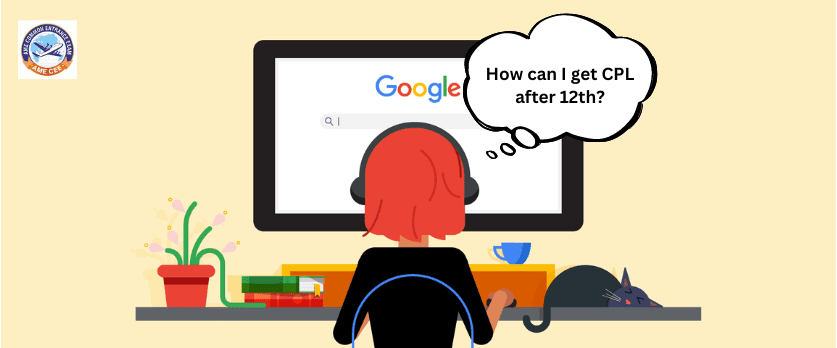Obtaining a Commercial Pilot License (CPL) is a significant achievement and involves a structured process. Here are the general steps to pursue a CPL after completing your 12th grade:
Educational Qualification
Ensure that you have completed your 12th grade with Physics and Mathematics as mandatory subjects. Many aviation authorities require a science background for CPL eligibility.
Select a Reputable Flying School
Research and choose a recognized and accredited flying school. Ensure that the school is approved Directorate General of Civil Aviation.
Medical Examination
Undergo a Class 1 Medical Examination from an aviation medical examiner. This is a mandatory requirement to ensure that you meet the medical standards necessary for flying.
Private Pilot License (PPL)
Enroll in a Private Pilot License (PPL) course. This training includes both ground school and flight training. You will learn the basics of aviation, navigation, meteorology, and aircraft operation.
Accrue Flight Hours
Accumulate a minimum required number of flight hours. The specific number varies by country but is typically around 200 hours. During this time, you will gain experience and further develop your flying skills.
Ground School for CPL
Complete additional ground school training that is specific to the CPL syllabus. This includes in-depth knowledge of aviation regulations, navigation, meteorology, and other relevant subjects.
CPL Theory Exam
Pass the CPL theory exams. These exams cover the subjects studied in ground school and are administered by the aviation authority.
Instrument Rating (IR)
Obtain an Instrument Rating (IR), which allows you to fly in a wider range of weather conditions. This is an additional qualification often pursued during CPL training.
Build Flight Experience
Continue building flight hours, gaining experience in various weather conditions and types of aircraft.
Multi-Engine Rating (ME)
Some CPL programs include Multi-Engine Rating (ME) training, allowing you to fly aircraft with multiple engines.
CPL Flight Test
Pass the CPL flight test, which is conducted by an authorized flight examiner. This test assesses your ability to operate an aircraft safely and proficiently.
Apply for CPL
Submit your CPL application to the aviation authority. This may include providing evidence of completed training, flight hours, and passing the required exams
Interviews and Selection
If you are seeking employment with an airline, be prepared for interviews and selection processes. Airlines often have their own additional training programs.
Type Rating (if applicable)
If you plan to fly a specific type of aircraft, you may need to undergo type rating training, which is specific to that aircraft model.
Continuous Learning
Stay updated on industry regulations and advancements. Continuous learning is crucial in aviation.
FAQs on How to Obtain a CPL After 12th
Q1. Can I pursue a CPL directly after completing my 12th grade?
A. Yes, you can start the journey toward a Commercial Pilot License (CPL) after completing your 12th grade.
Q2. What are the mandatory subjects required in 12th grade for CPL eligibility?
A. Physics and Mathematics are generally required as mandatory subjects for CPL eligibility. A science background is typically preferred.
Q3. How do I choose a suitable flying school for CPL training?
A. Research and choose a recognized and accredited flying school. Consider factors like reputation, facilities, and approval from the aviation authority.
Q4. Is a medical examination required before starting CPL training?
A. Yes, a Class 1 Medical Examination from an aviation medical examiner is mandatory to ensure that you meet the required medical standards for flying.
Q5. What is the difference between Private Pilot License (PPL) and CPL?
A. PPL is the initial step and allows you to fly for personal purposes. CPL is a professional license that permits you to be compensated for your flying services.
Q6. How many flight hours are required for CPL?
A. The minimum flight hours required for CPL vary by country but are typically around 200 hours. This includes both solo and dual flight hours.
Q7. What subjects are covered in the CPL theory exams?
A. CPL theory exams cover subjects such as navigation, meteorology, aviation regulations, and aircraft operations. These exams are administered by the aviation authority.
Q8. Do I need additional ratings like Instrument Rating (IR) during CPL training?
A. Yes, an Instrument Rating (IR) is often pursued during CPL training. It allows you to fly in a wider range of weather conditions.
Q9. What is the CPL flight test, and how is it conducted?
A. The CPL flight test is a practical assessment of your flying skills and knowledge. It is conducted by an authorized flight examiner and evaluates your ability to operate an aircraft safely and proficiently.
Q10. Can I apply for CPL immediately after completing the training, or are there additional requirements?
A. After completing the required training, you need to pass the CPL theory exams and accumulate the specified flight hours. Once these criteria are met, you can apply for CPL through the aviation authority.
To become an commercial pilot you may could join commercial pilot license through AME COMMON ENTRANCE EXAM (AME CEE) this examination you may join Commercial Pilot License approved by DGCA.


